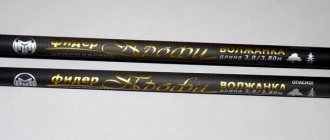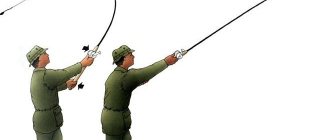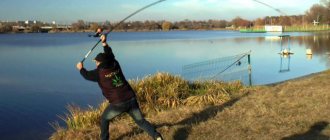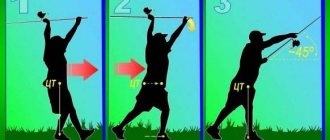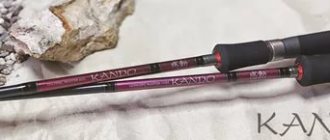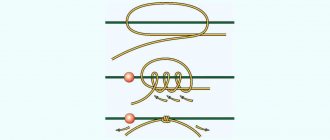Safety precautions
When casting, you should strictly adhere to simple rules that will protect the fisherman and his neighbors from injury:
- Long-distance casting with a spinning rod is carried out with sweeping movements, which can easily hit someone standing next to you. The blow may not be strong, but the effect of surprise will play a big role in this.
- If you are not careful when casting, you can catch your neighbor on the hooks. If the snag happened only on clothing, we can say that you are lucky.
- Beginner fishermen very often catch themselves, and the hooks cling not only to clothes. Puncture wounds are often inflicted with hooks, and sometimes such fishermen end up in the surgical wards of hospitals.
It follows from this that you should maintain a certain distance and not stand too close to the spinner, especially while casting. It's better to take a walk along the shore and get some fresh air.
The most commonly used casting options are vertical and side
Vertical cast
It is believed that vertical casting of bait has maximum accuracy and range. This casting option is well suited for large bodies of water with a fairly clean shore, on which there are no trees hanging low over the water, or a wall of bushes reaching right down to the water. The technique of casting a spinning rod vertically is quite simple:
- First, you should select the length of the line overhang (depending both on personal preferences and on the characteristics of the bait and rods), open the line handle, and the line or cord is fixed with your index finger.
- The form must be placed behind your back.
- With a quick movement of the rod you need to send the bait forward, and it is important to release the line in a timely manner.
It should be taken into account that when fishing under power lines, this technique is the most dangerous - if you do not release the line in time, the bait can go quite high up and remain on the wires. This situation can be dangerous for the fisherman himself, because carbon blanks conduct electricity well.
Photo 1. Vertical casting diagram.
Side cast
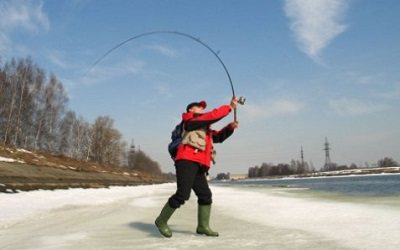
The horizontal option is good to use in the presence of tall vegetation, which often makes a vertical throw impossible. Also, this type of casting of a spinning rod is often used by novice spinners, as it is one of the easiest to learn. This is how they cast not only in the presence of vegetation, but also in unfavorable weather conditions, such as, for example, a strong side wind.
We invite you to familiarize yourself with: Hide for goose hunting
Important! It is better not to fish under power lines at all, but if you really want to, it is better to cast horizontally rather than vertically, as there is less chance of sending the bait onto the wires.
How to choose a spinning rod for long casting
Not every rod is suitable for throwing the bait at the maximum possible distance. A spinning rod for this method of fishing must have certain characteristics that will contribute to successful fishing.
The casting distance of a spinning rod depends on:
- length of the form;
- building;
- number and placement of rings;
- test.
It is these indicators that are relied upon when choosing a rod for spinning tackle for long-distance casting. Each of them will play an important role and you should not neglect any of the above.
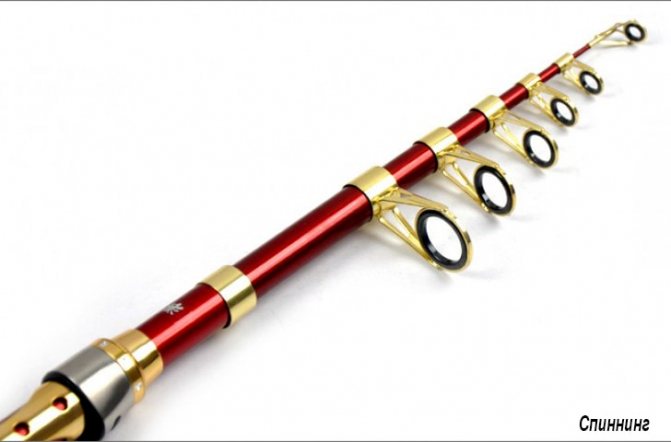
Each manufacturer has in its arsenal several models of forms that are designed specifically for this type of fishing. The assortment is updated periodically and some changes are made. The reel seats are being replaced, the quality of the inserts on the guides is being improved, and higher quality material is being used to make the rod. But the system and test indicators remain virtually unchanged.
The tests carried out showed a certain pattern; length is not always the main indicator of casting distance. The entire set of gear is important. The casting distance table is as follows:
| Spinning rod name | 20 g | 30 g | 40 g |
| Balzer Edition 2.8 m, 30−60 g | 99 m | 109 m | 110 m |
| Daiko Desperado DS-1102M, 3.35 m, 20−42 g | 100 m | 105 m | 111 m |
| Daiwa Whisker 10′, 3.05 m, 10−60 g | 99 m | 100 m | 115 m |
| G. Loomis 10′, 3 m, 14−56 g | 96 m | 99 m | 112 m |
| Daiwa Emblem-Z (Interline) 10′, 3 m, 15−60 g | 94 m | 106 m | 119 m |
| Daiwa Grand View-X 10'6″, 3.2 m, 12−50 g | 92 m | 99 m | 109 m |
| Lamiglas X89MTS 8'9″, 2.67 m, 14−39 g | 92 m | 96 m | 105 m |
The results prove the importance of all components. It is not necessary to buy a letterhead from a famous world brand at an exorbitant price. You can fish perfectly with a middle-class rod from a lesser-known company and still significantly outperform your friends in catches.
Factors affecting casting quality
Quality is influenced by a large number of different factors:
- wind;
- obstacles on the shore;
- compactness of the bait used;
- weight and aerodynamics of the bait;
- fishing line;
- coil used;
- rings;
- rod action, test and length;
- line diameter.
Rod design
For each rod there is a certain technique that will be optimal. It depends on the length and structure of the form: for some, softer and sweeping throws are preferable, for others it will be better to practice short and sharp ones.
If an angler regularly fishes with a particular spinning rod, he will be able to hone his casting skills with this rod in different conditions.
Bad weather
When fishing with a spinning rod, it is necessary to make allowances for the wind: the side wind has a significant impact on the accuracy of the cast, and the headwind or the wind at the back has a significant impact on the casting distance.
Wind is one of the factors, namely:
- Side wind. Leads to a significant reduction in accuracy as well as range.
- The wind is in your face. Such weather conditions lead to reduced range.
- The wind is at your back. Leads to a significant increase in casting distance.
Features of spinning rods for long casting
Such forms are not suitable for spinning from the shoreline; with their help it is impossible to cast the bait to the required distance. The long casting method is mainly used for fishing:
- asp, since this fish is particularly careful and feeds far from the shore;
- salmon in rivers, where you also need to cast spoons over long distances;
- jigging on medium and large rivers to catch larger specimens of predatory fish species.
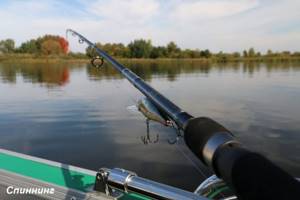
Using a long-cast spinning rod you can successfully catch:
- various irregularities in the riverbed, including edges in the middle of the river;
- riffles at great depths;
- This method also works well for holes and elongated ditches in large bodies of water;
- distant snags and flooded trees become a haven for many fish; only long casting will help in catching them.
To fully explore all these places and fish for a great trophy, you should know the features of spinning rods for long-distance casting. The most important indicator should be the length, because as mentioned above, a small form will not be able to make a decent throw of the cord or fishing line to the required distance. These rods are good for fishing from a boat or from the shore in small bodies of water.
A tall blank can cast 100 meters or more with a minimum of effort by the angler; this is facilitated by the characteristics originally built into it.
The second thing to pay attention to is the system; not everyone is suitable for working at long distances. After all, in addition to casting, the rod must show a good bite so that the fisherman can hook the trophy in time.
Along with this, other spinning rod components for long-distance casting are also important; now we will look at them in more detail.
Types of casting
Side
The most common type, which is carried out from the shore. It is perfect when there is a gusty headwind, or when the shore is heavily planted with bushes, which will be very disturbing. When areas of the reservoir are massively covered with aquatic vegetation, this species will come in handy for casting a spoon under this vegetation.
In a side view, the bait should hang 20-30 centimeters from the end of the spinning rod. We move the rod back to the side opposite from the one in which we hold it. Having cast, we observe that the rod moves forward and slightly upward, during this period of time the fishing line drops.
The cast is considered successful when the bait falls exactly in front of us. Side casting does not differ in extreme accuracy, but for beginners it is the most convenient and easiest.
Over the head
This type allows for almost 100% accurate casting, but it can only be done with a spinning rod equipped with a spinning reel. With an inertial reel, casting accuracy will be reduced by almost half.
We can say that this is the main type of casting for many fishermen. Suitable for fishing from a boat and on the shore near bushes. The most common mistake made by beginners trying this method is excessive use of their own strength and pausing by lowering the spinning rod extremely low behind their back.
With such errors, the accuracy will be extremely reduced. During casting, the bait should move in an elongated circle. When it reaches the extreme position behind the fisherman, it must continue moving forward without stopping, while picking up speed.
From under the hand
This type of casting is fairly close, which can be used on the shore, where dense vegetation predominates , as well as when fishing together on a boat, where the fisherman sits almost closely behind him.
For this variety, a closed-type reel and, of course, a spinning reel are perfect. We pull the rod out with one hand in an almost horizontal position in front of us, then tilt the tip of the tackle down, point it towards us, and then lift it.
When the stick takes a horizontal position, release your finger from the spool so that the prepared bait is in free fall.
Over shoulder
In narrow places, you can use the over-the-shoulder casting technique. To do this, we hold the end of the tackle handle with one hand, and with the other near the reel, throwing the rod vertically and tilting its tip over the shoulder, making sure that our reel is above the shoulder.
Having tilted the top almost to the ground, we sharply jerk forward, but in order not to overdo it, remember that the forward swing should not be further than our head. Having the rod above your head gives us a signal that it’s time to let go of your finger from the spool and allow the bait to free fall.
When the descent of the reel comes to an end, we tilt the top of the spinning rod in the direction where our bait went.
With two hands
Using the same scheme, you can make a cast more powerful than the previous ones thanks to this type. But you should know that it will require much more arm and body tension than the varieties listed above, and you will also need a two-handed rod.
Problems that may arise during application:
- The presence of a large amount of fishing line on the spinning reel. They will get tangled when unwinding.
- Light bait and small guides will not allow us to make a long cast.
- To avoid tangling the line on a reel with a missing line guide, you need to help with your thumb and forefinger when winding the line onto the spool.
Having arrived at the place and started choosing the position from which we will cast, we pay attention to:
- The influence of the current if we fish in flowing waters.
- We roughly estimate the amplitude of movement of our bait.
- The fish will not want to follow the bait that is facing the sun, so we choose a place to cast at a low angle to the sun's rays.
Coil
Most often, such tackle is equipped with a high-quality spinning rod without inertia. For long-distance casting, a reel with 3-6 bearings and a spool of 2-3 thousand will be enough. Such parameters will allow you to cast to the required distances, will not make the equipment heavier, and will allow you to retrieve and land even a large specimen of the catch without any problems.
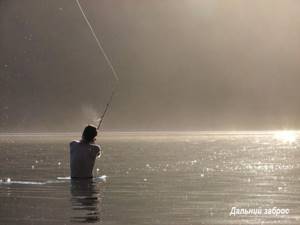
Multipliers are also used for spinning rods of this type; with a well-adjusted clutch and practiced casting with such a reel, the bait will fly further. A special feature of using such a reel will be a smoother casting and retrieving of the catch.
Preparing to cast with a spinning rod
The gear is collected, the bait is hung! Rather, we throw... But... Before you finally throw the bait, be sure to look: firstly, what is behind there, and secondly, where, if successful, you will pull out the fish.
After all, the most common way to break a spinning rod is to catch the bait on the grass or branch when casting. This can happen completely unnoticed by the fisherman, especially during moments of active biting or “fighting” of fish. Therefore, it is advisable to monitor each time where your bait is directed when swinging. After all, sometimes grass and bushes grow on a clean shore, and you can easily “catch each other” with a friend in a boat. Don’t forget about the “curious” ones who can quietly come up behind you and quietly observe your skills.
An even greater nuisance will be catching a large fish in a place where it is practically impossible to pull it out. Therefore, even before casting, realistically assess the likelihood of “taking” the prey, and look at the place where you will have to pull it out. If our chances of winning are scanty, it is better to choose another “point” for casting.
Build
A slow or parabolic action of the blank will help you cast your chosen bait further away, but it will be difficult to determine the bite from them. This is precisely the main reason for the gatherings. A rod with a fast or medium-fast action will perfectly combine the characteristics necessary for long casting.
The slightest bite will be reflected on the tip of the spinning rod, and casting will be carried out without any problems.
Using an elastic band on a clip
The weight should be selected wisely; a sinker that is too small will not fly far, and a sinker that is too heavy will be difficult to cast far, and there is a possibility of breaking the rod if the casting technique is incorrect.
Loads from 50 to 100 grams are considered the most long-range, although there may be exceptions. Regarding the thickness of the fishing line and cord, everything is also quite simple here; the thinner it is, the further you can cast it with the feeder.
Related article: how to choose a feeder rod
Passing rings
The rod rings serve as a support; the more of them there are on the form, the more evenly the load is distributed along the rod. The main thing is that the inserts in the guide rings are intact and of high quality; this is what will determine the speed of the cord or line when casting.
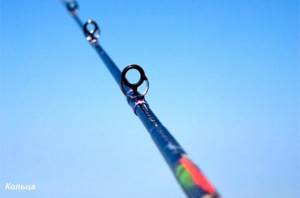
If one of the rings is flawed, then making a long cast will simply not be possible, the line will simply be cut.
Rod build
A typical phenomenon among the fishing fraternity is that any fisherman, without much difficulty, with a businesslike look, will explain in which part the rod bends with the “Fast” action and with the “Slow” action. But at the same time, getting a simple explanation from this fisherman about what the difference is and what it gives when casting is not always possible. I’ll try to do this myself by analyzing the casting with the “Fast” and “Slow” forms.
The “Fast” rod blank, under the influence of the current load, bends by 1/3 of its length. At the moment of casting, this flexible part performs a sharp but short movement. This movement occurs sharply and the time from the swing of the rod (at the moment of casting) to the moment when the feeder begins its independent flight is very short. “Slow”, due to its design features, can bend along its entire length. Almost to the very butt. Due to the increased flexibility at the initial stage of casting, the blank bends strongly and its tip at the moment of the swing cast seems to lag behind the movement of the butt part itself.
It turns out that when the movement of the hands has stopped, the rod still continues to move (straighten), gradually accelerating, so that at the end of the swing movement it throws the feeder into free flight. The time from swinging the rod to the moment when the feeder begins to fly by inertia will be longer than when casting with a rod with a “fast” action. The conclusion is obvious: with an equal value of the applied forces, the speed of the feeder at the beginning of its free flight will be greater when casting the blank in the “Slow” formation. Consequently, the higher the speed, the further the thrown equipment can fly.
A similar phenomenon of “long-range” can be observed in small arms. Short-barreled weapons are inferior in firing range to long-barreled ones, since the acceleration force generated as a result of the action of powder gases on the bullet acts for a different amount of time and creates a different ejection speed.
Speaking about the importance of the formation for casting distance, I will note one more fact that you can check yourself. The cost of rods of different construction, but the same length and test, made from the same material and from the same company will be different. A “slow” action blank is always more expensive, and not only because it requires special design solutions in its manufacture!
How to make long casts with a spinning rod
Not everyone can cast correctly over long distances; sometimes it takes more than a year to perfect the technique. But regular training will not always give the desired result.
To make a long cast with a spinning rod to the required distance, you should adhere to the following general rules:
- hold the form with both hands;
- make some effort;
- make sufficient scope;
- first lower the bait on the fishing line at least to the middle of the rod.
There are several techniques that experienced anglers use. Everyone chooses the one that is most suitable for him.
Basic methods for making long casts
Let's talk about the methods by which long throws are made using a spinning reel:
- Before casting, prepare the rod. We release the line-laying arm and release the bait to almost the full length of the stick. We throw the bait forward with a smooth movement, after which we turn sideways and sharply send it towards the target from behind. A significant disadvantage of this method is the low casting accuracy.
- As in the first case, we open the line guide, but release the bait only to the level of the reel. Smoothly move the bait behind your back and perform an accurate throw. At the same time, the fisherman’s body moves along with his hands.
- We release the line guide and release the bait along the entire length of the fishing rod. Raise the spinning rod above your head so that the handle of the tackle points to the intended point. We lean on the front leg, and tilt the body to the side and back. At the same time, with both hands and the body we send the bait to the intended place. This technique allows you to get the most accurate and farthest casts.
Casting technique
The most popular is the simple casting method, which is carried out “from behind the ear”. To do this, the rod is simply brought back, before this the spoon is slightly lowered, the spinning reel bracket is thrown away and the cord or line is lightly held.
When casting, you need to make every effort, then the bait will fly in the desired direction and at the required distance.
At the moment of casting, the line is released, thereby allowing it to be reeled out freely.
At the moment of casting, the rod should be at an angle of 45 degrees relative to the shore.
How to Increase Casting Range
Rod testing, leaders, knots, line lay are all important factors, but as England's long-casting champion, Mark Hutchinson believes that practice, technique and the use of the right tools make long-distance fishing accessible to everyone.
Nowadays, many of us are heavily armed with equipment: no matter what distance we fish, having the right weapon in our arsenal always carries a great advantage. Once on the shore, the first thing we do is choose a promising fishing point.
However, I have had countless situations where the desired location was 20-25 meters away from the casting distance to reach the active fish. In this case, you shouldn’t run to the store for a new “miracle” wand, which will cost a lot of money, but you need a little training, knowledge of some nuances - and unattainable places will not be so ghostly.
I arrive ashore just before dawn as other anglers begin to hastily gather around Mark's car. A few minutes later everything is ready, we have prepared our notebooks and are listening to the master.
“Okay, let's start with the fact that casting distance is influenced by several factors: technique, balanced tackle, proven materials and components. Even minor changes in casting technique will help you avoid buying new equipment, so let's start there.
Although many people think they have reached their maximum, using the correct casting technique can significantly improve your performance. Even after several training sessions, the results of many of my students increased by 10 meters or more. I will repeat in advance for the thousandth time: no matter how strong your hands are, always wear a quality finger guard, or you will have serious problems.
First, the stance. You should not rest flat on both legs; in the initial stage, your weight should be on the back leg. The left (right-handed) foot is in front in the direction of casting, the right leg is behind and the foot is at an angle of 90 degrees with the knee bent, 65-70cm from the left. Both arms should be fully extended, the rod should be parallel to the surface of the ground and directly above your head.
The distance from the tip to the sinker should be the length of the top of the rod. When using stiff rods and a powerful jerk, you can slightly increase this length. With soft rods, the process is the opposite; you should slightly reduce the distance between the sinker and the tip of the rod.
Rating of long-casting spinning rods
Each manufacturer considers it necessary to have a couple of models of spinning rods specifically for long casts, and they can be very different in cost. The most popular are:
- Norstream Kando 962H;
- Daiwa Whisker 1002MHS;
- Daiko Absolute 1002MHXF;
- Banax Thunder 100MHXF2;
- Pontoon21 Psychogun 1072MMH SF.
It is these forms that are most often purchased by both beginners and experts in this business. Choosing a spinning rod is not as difficult as it seems at first glance, you just need to pay attention to some nuances and you are guaranteed a great catch.
Long-distance casting gear layout
Above we looked at how to choose a spinning rod for long-distance casting. When assembling long-range gear, other elements are also important:
- Coil.
- Fishing line.
- Bait.
In most cases, anglers use a spinning reel. It is worth noting that with a multiplier, with the correct technique and a properly adjusted clutch, the casting of the same bait will be further. However, this does not apply to situations where you need to assemble a spinning rod for casting light baits.
The unskilled fisherman must lay the cord on the spool efficiently. If it lies flat without dips or humps, then a decent casting distance is guaranteed. Otherwise, the reel will throw loops, create overlaps and form beards.
We pay special attention to the side of the spool. It should be perfectly even and smooth, without defects. Chips and unevenness will shorten the casting range of the bait and spoil the fishing line, which will subsequently lead to an unexpected break at the most inopportune moment during fishing.
The thinner the cord or monofilament, the further the bait will fly. It is important to compare the weight of the spoon and the breaking load of the fishing line, so as not to break it during a power cast. It is better to give preference to braid with a smooth structure or put nylon on a spinning rod; then the casting range will be maximum.
It is impossible to make long casts using floating bulk baits for spinning rods, since in the air they provide strong resistance, which conceals precious flight meters. Without a suitable set in your fishing box, you shouldn’t go out onto a large body of water. A good-quality spinning rod for casting without a compact, far-flying spinner will not help.
The best lures for long-distance fishing are narrow-bodied jig-class oscillating spoons. They have no equal in terms of flight range. Unfortunately, these spoons are not always suitable for fishing conditions and potential catch.

